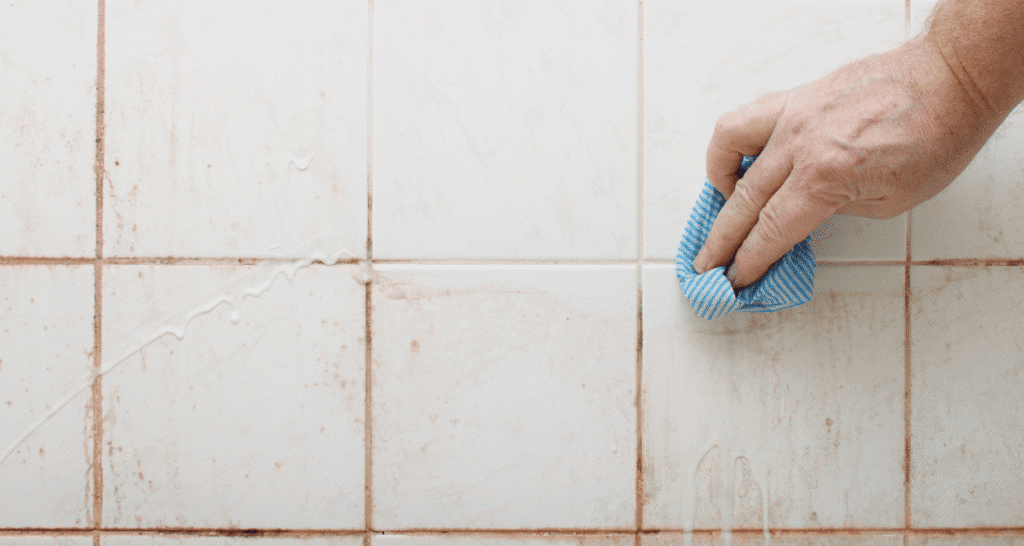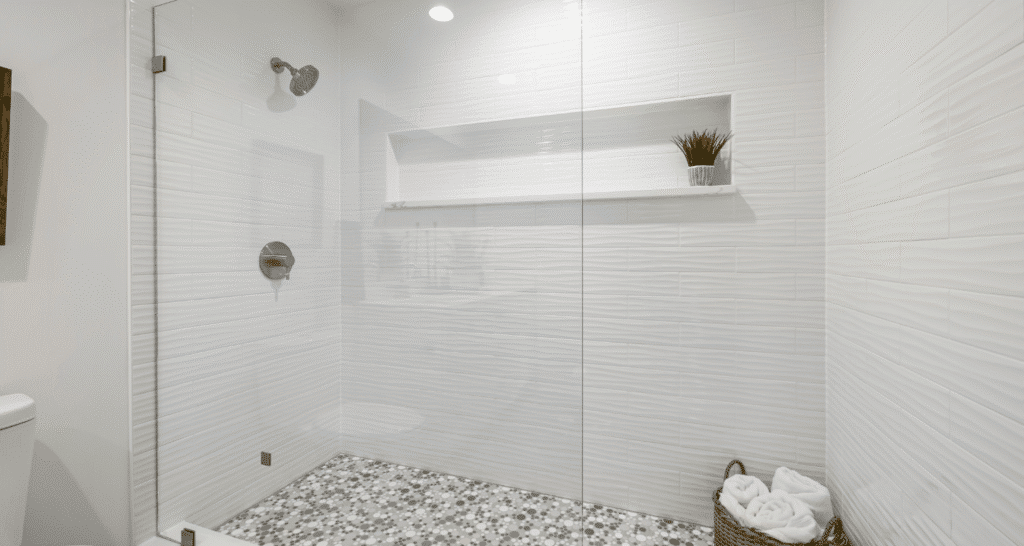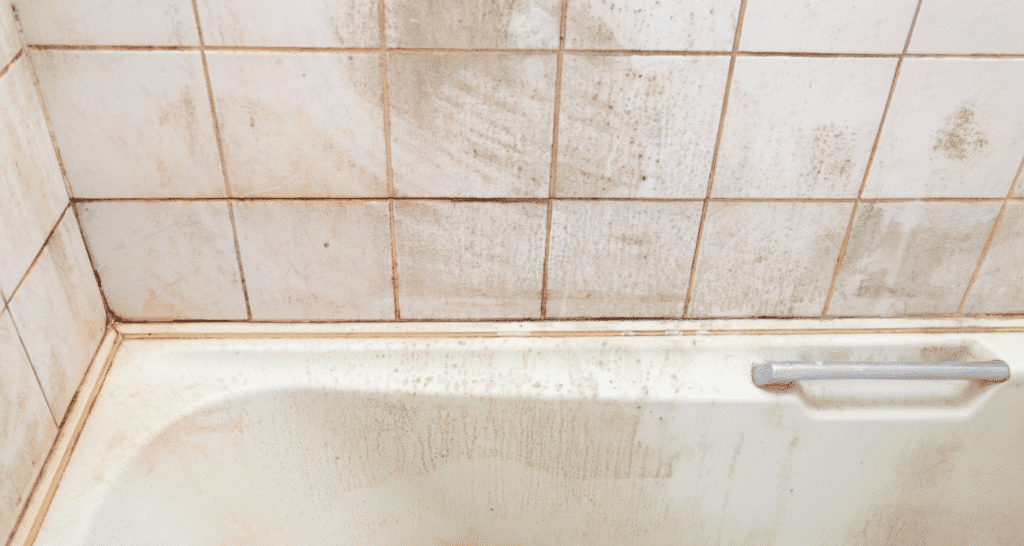Your bathroom is always one of the most essential areas to keep clean and healthy, but even the cleanest shower can appear dirty and unwelcoming when these orange stains are present. Not only are these stains unsightly, but they can also indicate more serious problems, such as mold, bacteria, or hard water precipitates. To prevent orange stains in the shower, it’s important to understand why they happen, the dangers they pose, and how to clean them out so you can keep your bathroom clean and your family safe.
Causes of Orange Stains in Showers and Bathrooms
When orange stains appear in showers, bathtubs, wash basins, and sinks, it is most likely the result of either hard water that contains a high amount of iron or orange mold. Iron in water gets oxidized in the air to form rust crevices. Additionally, Serratia marcescens, a common bacterium that can be easily mistaken for mold, grows in moist, soapy conditions and forms an orange-pink biofilm on the walls of showers, grout, and floors.
Orange stains may also manifest themselves in tiling, such as in grout, where uneven surfaces absorb moisture and soap scum. These factors, in the long run, lead to stubborn stains that are difficult to clear and, to the eye, an unpleasant sight. Effective elimination and prevention in the long term require identifying the exact cause.
Is Orange Mold in the Shower Dangerous?
Although the orange mold making a home in your shower may not be visually appealing, it can pose health hazards and be problematic for individuals with a weakened immune system, respiratory issues, or allergies. Serratia marcescens has been known to cause wound, urinary tract infections, and respiratory infections. It is not as hazardous as black mold; nevertheless, long-term exposure may also produce undesired side effects, such as skin irritation and allergies.
In families with children or older adults, the eradication of orange mold is not only an aesthetic issue but also a health-related one. Maintaining the surfaces dry at all times and applying adequate shower cleaner liquid will help reduce the health risks posed by orange mold in the shower.
Types of Shower Stains and What They Mean
There are many forms of discoloration that a shower can have other than orange stains. Black stains normally portray mold or mildew. Additionally, there may be white chalk residue due to hard water and calcium deposits. Another way Serratia marcescens disease manifests is through pink stains and green or blue discolorations, which indicate the destruction of copper pipes. These differences may help you select the most effective shower stain remover for the specific issue at hand.
The possibility of orange tints on the grout and floor of the shower is caused by a multitude of factors that often occur together, such as mold growth and mineral accumulation. By determining the nature of the stain, you can use the most suitable tile cleaner or homemade shower cleaner solution.

The Best Cleaner for Orange Mold in the Shower
The most effective cleaner for orange mold in the shower contains a mixture of disinfectant agents that kill mold. Commercial products, such as bleach-based bathroom cleaners, can be effective, but natural products can also be beneficial. The homemade shower cleaner, which combines white vinegar and baking soda, is also widely used because it can kill bacteria and dissolve mineral stains.
To clean stubborn stains, hydrogen peroxide is a very effective tile cleaner and can be applied directly to grout. It should be left to sit for 10 minutes, then scrubbed using a shower cleaner brush. Wash the area thoroughly to avoid breathing in fumes or lingering odors.
How to Remove Stains from Shower Floor and Walls
To clear stains on the shower floor and walls, first spray the affected area with a shower cleaner liquid that removes all kinds of mold and mineral buildup. Leave it to stand for a few minutes to dissolve dirt. Use a firm bristle shower cleaner brush. Clean the surface meticulously, paying close attention to texture and corners where stains tend to accumulate.
To clean deep-set stains in grout, use a baking soda paste with water or hydrogen peroxide. Use an old toothbrush, scrub brush, or grout brush to apply the paste. Wash the area with water, and repeat as often as necessary. With frequent orange stains in the bathroom, re-cleaning the area every week will help remove the stains until no stain appears.
Cleaning and Maintenance Tips for Wash Basins and Sinks
Orange stains in sinks and wash basins can also be based on the causes of shower stains, namely, the use of iron-laden water and mold. Buildup can be avoided by regular cleaning using a non-abrasive tile cleaner. An easy but efficient homemade solution to clean the sinks is through a neat solution of vinegar and water applied on the surface, which should then be wiped with a microfiber cloth.
There is a tendency for repeat stains in the sink, and in this case, a water softener or filter system should be considered. These facilities are able to reduce the amount of iron and minerals in your water, thereby avoiding future stains and extending the lifespan of your bathroom fixtures.
Tips to Prevent Orange Stains in the Shower
Failure to prevent orange mold and mineral stains in the shower can be averted. Dry your shower walls and floor with a squeegee or a towel after each use to remove excess moisture. Ensure sufficient ventilation in your bathroom by using fans or opening windows, which helps maintain a low humidity level that prevents mold growth.
Water softener application is another useful preventive measure. It also lowers the amount of iron in the water, thereby reducing rust-colored stains. Additionally, you can take a shower by spraying it every day to prevent the development of mold and mildew. Your bathroom will remain stain-free after regular cleaning and the removal of visible stains.
Choosing the Right Shower Stain Remover
When choosing a shower cleaner, avoid generic options and opt for one that specializes in removing mold, mildew, and mineral discolorations. Bleach, hydrogen peroxide, or citric acid products are typically effective in removing orange mold in the shower, as well as hard water stains.
In the environmentally friendly case, most plant-based cleaners can be effective in cleaning with minimal chemicals. You only need to ensure they are marked as safe for use on bathroom surfaces. Whenever possible, it is best to test the cleaner on a small area of tile before use, so that discoloration or damage does not occur, particularly on delicate tiles or natural stone.
Also Read: Luxury Bathroom Vanities for Elegance!
Benefits of Regular Shower Cleaning
Maintaining a clean shower is also of great health advantage. Cleaning the shower regularly helps to prevent the growth of dangerous bacteria, molds, and fungi, which decreases the risk of suffering from breathing-related problems or skin irritation. A clean shower also helps to make the house healthier for allergy sufferers.
Besides the health aspect, having a stain-free bathroom contributes to the beauty and overall attractiveness of your house. When you are selling or renting your property, a clean bathroom will make it more appealing and increase its value. If you’re considering a full upgrade, explore our bathroom remodeling services to enhance your bathroom’s look and functionality even further.

Effective Tools for Shower Cleaning
The same applies to shower cleaning, as having the right tools is essential. A well-built shower cleaner brush is useful for scrubbing at grout and corners. Using microfiber cloths and squeegees makes drying the surfaces easier, and mold can be prevented.
Consumers who are more interested in an automated process can help deal with the time-consuming task of removing tough stains in tile grout or on the shower floor using electric scrubbers. Additionally, use these tools in conjunction with a strong shower cleaner liquid or one of your favorite homemade mixtures.
Final Thoughts and Long-Term Solutions
Orange stains in your bathroom not only affect its cosmetics; there are causes of such stains that require care. It is also possible to eliminate current stains and prevent future ones by understanding their causes, such as mold and mineral buildup, and using suitable products and methods. One of the best long-term solutions to maintain a clean and fresh bathroom is regular cleaning, proper ventilation, and treating your water. Additionally, upgrading your space with an expert bathroom remodeling can enhance cleanliness, functionality, and style for years to come.
In a search for homeowners to remodel or upgrade their bathroom systems to avoid such incidents, Builders Group Construction provides experienced advice and specific solutions. Our experts can help you create a better and cleaner bathroom with high-efficiency fixtures and mold-resistant materials.
FAQs
What causes orange stains in the shower?
Orange stains mostly come from hard water that is high in iron. When iron corrodes, it rusts, leaving behind rust stains. Mold or bacteria can also cause orange discoloration, especially in damp areas.
How to get rid of orange limescale
On the stained area, pour white vinegar spray and let it sit. Wash with a stiff brush or sponge. Rinse it off with warm water and repeat if necessary.
What causes orange stains in the bathroom?
The most common reason for orange stains is the presence of iron in hard water. Mold and soap scum can also combine to produce a similar color. These stains are typically found in sinks, tubs, and around drain pipes.
How to get orange rust off a shower?
Use a rust remover or a paste made from baking soda and vinegar. Put it in the rusty area and clean it in 10 minutes. Clean the area well and dry it to avoid any further staining.
Why does my shower keep going orange?
Your water probably contains excessive iron, which is continuously causing staining. Poor ventilation and stamp overwrites also permit mold to grow. Maintaining regular cleaning and drying can be helpful.
How to get rid of orange stains in the bathtub or sinks?
Use a bathroom cleaner or spray vinegar on the stain. Let it sit for a while, then clean with a non-abrasive sponge. Rinse thoroughly and tap dry to prevent the stain from returning.
How to Remove Shower Stains from Glass?
Spray a mixture of water and vinegar in a spray bottle and brush the glass. Let it sit for a few.








